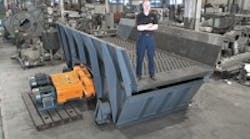For today's metalcasters to be successful, the operational formula is simple: produce more high-quality castings with less equipment, people, and maintenance. In many foundries, the shakeout has been an expensive roadblock on this path to success. Decades-old foundry technology has contributed to increasing operating costs while limiting the ability to adjust to ever-changing customer demands.
A radically new technology, however, will put those old shakeouts in the industrial museum. The new Delta Phase Shakeout will improve a foundry's bottom line by reducing maintenance costs, reducing or eliminating casting damage, and maximizing sand removal. Perhaps more important, this single machine will handle a wide range of molding processes, mold sizes, metal types, and casting designs by adjusting to your ever-changing production demands.
Control conveying speeds retention time … precisely.
The heart of the Delta Phase Shakeout is the process controller. Using simple and reliable electronics, the Delta Phase Shakeout is able to control of the angle of vibration precisely. This change in vibration angle controls the conveying speed and retention time of castings on the shakeout deck, optimizing sand removal. The operators can accurately and automatically change this angle, even on the fly. A wide range of casting types and sizes can be accommodated by using pre-programmed settings. Each casting type can be assigned a set of predetermined shakeout parameters to optimize sand removal without damaging the casting.
Using common VFD and PLC technology, the angle of vibration is changed to meet each unique shakeout requirement. Most foundries produce a wide variety of casting shapes and sizes. When a fragile casting is processed, the angle of vibration may be lowered in order to reduce the retention time and the overall force imparted onto the casting. When a heavy casting is processed, the angle is increased to increase retention time and improve sand removal.
The Delta Phase is typically operated in "stop-n-go" mode or "continuous" mode. In "stop-n-go" mode, the angle of vibration is set at vertical once the mold reaches the center of the shakeout. Separation of sand from the casting and lump breakdown continues until the next mold approaches the shakeout. In continuous mode, the angle of vibration is set and maintained to provide the optimum retention time for the castings being produced. When a new casting is made, the angle of vibration is changed to its optimum angle.
Flexibility yields productivity
The Delta Phase Shakeout can be used for sand-to-metal ratios as low as 5:1 and as high as 60:1. The provided controls accommodate an unlimited number of recipes for diverse casting production. In addition to mainline sand/casting separation, the shakeout may also be used for lump breakers, sprue cleaning, and casting de-accumulation.
The Delta Phase Shakeout was designed with maintenance and process flexibility in mind. The last thing metalcasters want is more high-maintenance equipment. By reducing maintenance and increasing operational flexibility, the Delta Phase Shakeout will pay immediate dividends to any foundry operation.
Direct-drive reliability
The key feature of the Delta Phase Shakeout is directdrive technology. Direct drive is a simple, robust design that utilizes long-life, spherical roller bearings and eccentric weights to drive the system. The eccentric weights are inertially synchronized, which eliminates the need for any gearboxes or timing belts.
Compare this design to a two-mass natural frequency shakeout — with multiple vibrating masses and a forest of coil springs — and the advantages are obvious. Although the natural frequency design is precisely tuned to reduce the horsepower requirements of the shakeout, it is also very sensitive to any upset conditions or lax preventative maintenance. Most owners of natural frequency shakeouts are painfully aware of the problems that usually occur after a period of tough operation: sticking sand, jammed castings, and loose springs. The typical result is hours of downtime to repair cracks or replace springs.
The direct-drive design is not a tuned natural frequency system, therefore it is not sensitive to mass and speed changes or loose springs — all of which cause an overstroke condition. Overstroke is the leading cause of structural damage in all vibratory equipment. The Delta Phase Shakeout will not overstroke due to its direct drive design.
If you don't feel that you have an immediate need for equipment upgrades, consider the following:
- The new Delta Phase Shakeout can improve efficiency by producing more quality castings in less time than old machinery or processes.
- New equipment can increase safety and provide better working conditions for workers.
- It can achieve cost savings through reduced downtime and maintenance.
- Delta Phase Shakeout technology can improve production quality.
For more information, contact the engineering dept. at Carrier Vibrating Equipment, www.carriervibrating.com











